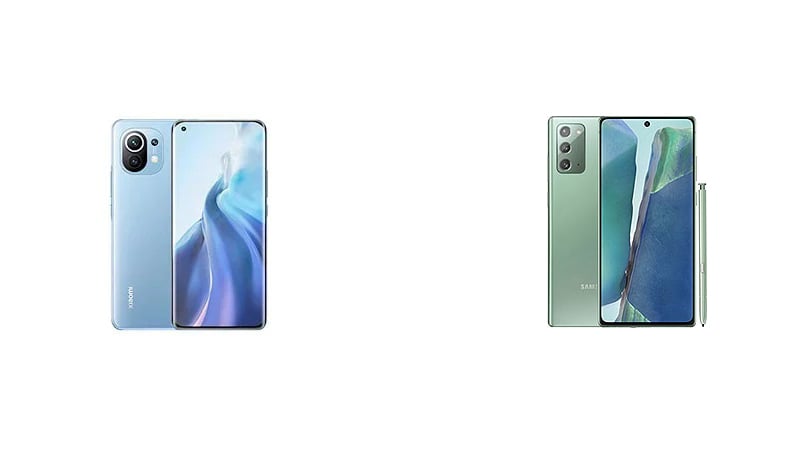Every time a new flagship killer hits the shelves, a lot of people wonder whether they should opt for the new arrival or for the top-tier flagships released by the concurrence during the previous year. Xiaomi Mi 11 just went official with the powerful Snapdragon 888 mobile platform, but is it really the best option in its price tag? In order to let you know this, we decided to compare it with the latest Samsung flagship in the same price range. Given that the Galaxy Note 20 Ultra is definitely too expensive for this comparison, we chose the vanilla Samsung Galaxy Note 20 for this specs comparison with the Mi 11.

Xiaomi Mi 11 vs Samsung Galaxy Note 20
| Xiaomi Mi 11 | Samsung Galaxy Note 20 | |
|---|---|---|
| DIMENSIONS AND WEIGHT | 164.3 x 74.6 x 8.1 mm, 196 g | 161.6 x 75.2 x 8.3 mm, 192 g |
| DISPLAY | 6.81 inches, 1440 x 3200p (Quad HD+), AMOLED | 6.7 inches, 1080 x 2400p (Full HD+), Super AMOLED Plus |
| PROCESSOR | Qualcomm Snapdragon 888, octa-core 2.84 GHz | Qualcomm Snapdragon 865+, octa-core 3 GHz or Samsung Exynos 990, octa-core 2.73 GHz |
| MEMORY | 8 GB RAM, 256 GB – 8 GB RAM, 256 GB – 12 GB RAM, 256 GB | 8 GB RAM, 256 GB |
| SOFTWARE | Android 11, MIUI | Android 10, One UI |
| CONNECTIVITY | Wi-Fi 802.11 a/b/g/n/ac/ax, Bluetooth 5.2, GPS | Wi-Fi 802.11 a/b/g/n/ac/ax, Bluetooth 5.0, GPS |
| CAMERA | Triple 108 + 13 + 5 MP, f/1.9 + f/2.4 + f/2.4 20 MP front camera |
Triple 12 + 64 + 12 MP, f/1.8 + f/2.0 + f/2.2 10 MP f/2.2 front camera |
| BATTERY | 4600 mAh, fast charging 50W, wireless charging 50W | 4300 mAh, fast charging 25W and wireless charging 15 |
| ADDITIONAL FEATURES | Dual SIM slot, 5G, reverse wireless charging 10W | Dual SIM slot, 5G, water resistant (IP68), S Pen |
Design
Despite it is a flagship, the Samsung Galaxy Note 20 does not come with premium materials like the Xiaomi Mi 11. Surprisingly, unlike top-tier flagships by Samsung, it has a plastic body. On the other hand, the Mi 11 offers a glass back protected by Gorilla Glass and an aluminum frame, as well as a display protected by Gorilla Glass Victus. It is sturdy, resistant, and very elegant thanks to its premium materials. But the Samsung Galaxy Note 20 has an important advantage: unlike the Xiaomi Mi 11, it is waterproof thanks to the IP68 certification.
Display
Samsung produces the best displays in the mobile sector, but in this comparison, Samsung Galaxy Note 20 is not the winner. The Xiaomi Mi 11 has a superior display with a higher Quad HD+ resolution and a higher 120 Hz refresh rate. Samsung Galaxy Note 20 has a Full HD+ display with a standard refresh rate. But even when it comes to the displays, Samsung has an advantage: the Samsung Galaxy Note 20 supports the S Pen for handwriting and drawing, a very interesting feature for productivity users. The Samsung Galaxy Note series and the Huawei Mate 40 series are actually the only series supporting pens thanks to an active digitizer.
Specs & Software
The Xiaomi Mi 11 wins the hardware comparison from every point of view simply because it has a more powerful processor. The Mi 11 is the first phone ever to feature the Snapdragon 888 mobile platform, which is the most powerful Qualcomm SoC released until now. With the Xiaomi Mi 11, you also get up to 12 GB of RAM and UFS 3.1 internal storage. The Samsung Galaxy Note 20 has an older and less powerful Snapdragon 865+ chipset in the U.S. variant and an even older Exynos 990 in the European version. But in each case, you get 5G support. Xiaomi Mi 11 ships with Android 11 out of the box, while Samsung Galaxy Note 20 ships with Android 10.
Camera
The Samsung Galaxy Note 20 is actually a more interesting camera phone. Xiaomi Mi 11 features an amazing 108 MP main camera, but it lacks a telephoto sensor. On the Samsung Galaxy Note 20, you get a 64 MP telephoto lens with 3x hybrid zoom, as well as a 12 MP main sensor with OIS and a 12 MP ultrawide camera. Last but not least, the Samsung Galaxy Note 20 features a better 10 MP front camera that can record 4K videos. In a few scenarios, you can shoot more detailed photos with the Xiaomi Mi 11, but the Samsung Galaxy Note 20 is definitely better thanks to its great secondary sensors providing more possibilities. The front camera of the Xiaomi Mi 11 is a 20 MP sensor but it is actually inferior and it can only record 1080p videos. On the other hand, you get 8K video recording from the rear camera.
Battery
The phones from the Samsung Galaxy Note 20 series are not exactly the best in terms of battery life, especially the Exynos version which has pretty high energy consumption. The Xiaomi Mi 11 has a bigger battery and it lasts more on a single charge in several scenarios, but the display is more energy-demanding. Both the phones feature wireless charging and reverse wireless charging, but you get way faster charging speeds with the Xiaomi Mi 11. The Mi 11 has 55W wired charging, 50W fast charging, and 10W reverse charging technologies, while Samsung Galaxy Note 20 stops at 25W, 15W, and 4.5W respectively.
Price
The listing prices of the Xiaomi Mi 11 start from about €500/$610 in the Chinese market. The smartphone is still not present in the global market, so we do not know how much it will cost. We will give you feedback once it hits the global market. The Samsung Galaxy Note 20 costs about €700 in the global market and you can buy it for $719 in the U.S. The results of this comparison are everything but obvious. The Samsung Galaxy Note 20 offers S Pen and more interesting cameras, which are important features for several users looking for high-end smartphones. It is even waterproof, unlike most of the phones out there. But with the Xiaomi Mi 11, you get a better display, design, faster charging speeds, and a better hardware department. We think most people would find the Xiaomi Mi 11 a more interesting choice, but productivity users and camera phone lovers would prefer the Samsung Galaxy Note 20. The price difference between these two devices is not relevant.
Xiaomi Mi 11 vs Samsung Galaxy Note 20: PRO and CONS
Xiaomi Mi 11
PRO
- Good price
- Best display
- Faster charging charging
- Better hardware
- Android 11
CONS
- No optical zoom
Samsung Galaxy Note 20
PRO
- Great camera with a telephoto sensor
- S Pen
- More compact
- Worldwide availability
CONS
- Inferior hardware







